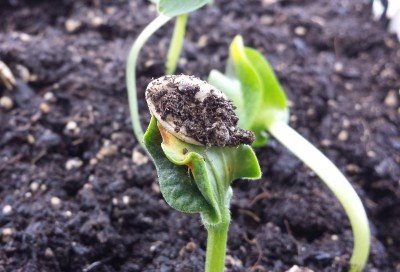
The point of this series is to get you going with a clear picture for yourself surviving a collapse of our support systems. Like this squash seed, saved from a Walmart squash, even slow growth eventually leads to an actual squash.
Resources:
Seedsavers: https://www.seedsavers.org/
Soil Blockers: At Johnnys
Soil Blockers: At Amazon
Survival Seeds: On Ebay
Russian Heirlooms: As seen here
The title of this week’s column was named intentionally to mean more than just specifically what we will be talking about. Nowhere in this series will you find, “go do this and you will survive!” There is no such thing. But building skills that you don’t currently have, and backing up those skills with some usable resources, is at this point prudent. All I can do is sow some seeds of knowledge and hope that in your own best interest, you will follow up and build a library of survival knowledge, and a pile of survival assets. If you have followed us from the start, you will remember a year ago when I wrote the first article on seeds, and my focus then was “don’t screw it up” (because you will, and it is better to get the screws ups under your belt). Here we are now a year later, and for most of the country, this is a great time to start some seeds. Danger of a last freeze is quickly passing, and it is time for new things to grow.
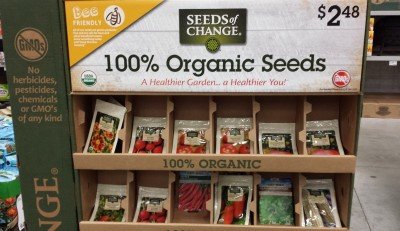
Seeds, both conventional and grown organically, are all over the place this time of year. This rack is at Lowes.
Whether you live in an apartment in Brooklyn or on exactly 1 acre in suburbia or 100 acres in Iowa, if you have never grown anything, it is time to start somewhere. Survival-scale gardening may not be part of your realistic long term survival plan where you currently live, but who knows where you will end up after the collapse passes. The cities may be uninhabitable, and you may be in a wave of refugees who flee to places where food can grow. At the very least, when someone says “have any of you ever grown vegetables before?”, you’ll be able to say yes. At the very most, your survival plan already includes a bugout location where you can garden, and you’ll actually make it there and survive. Gardening is so much more than putting seeds in the grown and hoping something grows, and the more you can teach yourself now, the more capable you will be down the road.
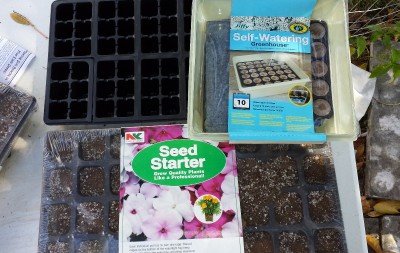
You can find trays for seedlings at most garden supply stores and even at Walmart. To get started, these work great.
In the first article I pointed you at some great sources for seeds, one of which is the organization called Seedsavers, as well as some Ebay sellers offering packages in bulk. Those same resources are still available, and the seeds are fresh from last year now, not 2013. These days there are even more people selling bulk seeds on Ebay, but you have to be careful with what you are buying. I found that if you look into the actual seed counts, you’ll find a lot of lettuces and grains, and very few tomatoes and eggplants. Part of this is because seeds from veggies with soft insides are hard to clean and dry, whereas lettuce and grain seeds are very easy to collect. So while you may think you are getting 500,000 survival seeds, it may be a half a dozen packets of things you really want to grow, and half a pound each of amaranth and millet.
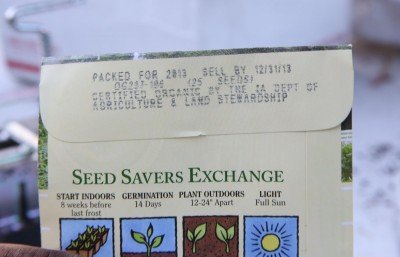
Rather than buy a whole bunch of new seeds, for this article I figured it would be good to show you that even seeds a couple years old will generally germinate. I didn’t store them in any specifically good conditions, but they were mostly in air conditioning.
For this article I planted mostly last year’s seeds that I had bought about this time last year. Plus I added some squash and tomato seeds I saved from supermarket veggies, just to show you that seeds don’t necessarily need to be purchased to work. I’m planning to write an article on saving seeds in the future, if we make it to the future, based on my own experiences saving seeds, some old seed saving references, and a new book that is coming out from Seedsavers in May.
A week later, I’ve already got more seedlings than I will be able to plant out, and even some of the slower seeds are starting to break through. Because while you can do a lot right and fail at seeds, you can also be somewhat haphazard, do a lot wrong, and still get plenty of plants.
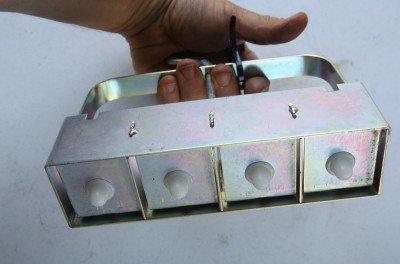
For long term survival, I think that these soil block makers are the best thing for seedlings. This is the 2″ size in a 4 block, that goes for around $35.
Soil Blocks vs. Flats vs. Egg Cartons
If you look back through the pictures a year ago, you’ll see that I used egg boxes to start seedlings. They work, as does just about anything else you could find to start seeds in, but egg cartons are hard to manage because they dry out quick and are difficult to water from the bottom, which I prefer. I am big fan of soil blocks for survival, because once you have the block maker, it is just a matter of composing a soil that will stay together for the blocks.
Never heard of soil blocks? What have you been living in a cave? Just kidding. Only about 3 people who read this will have ever heard of soil blocks before, but I was surprised to find out that these days they are not a niche a product as they were when I first discovered them in my prior life as an organic farmer more than 10 years ago. I figure at some point Kim Kardashian must have tweeted something about soil blocks because these days you can find the formerly obscure English made curiosities on Amazon, with free shipping.
Soil blockers come in four types that make 3 different sizes of blocks. The smallest blocker makes cubes about `1/2″ wide with a small indent in the top. They are great for lettuce, celery, and other small seeds, and I’ve used them successfully for seeds as big as tomato, eggplant and pepper. The next size up is a 2″ block, and if you are just going to get one blocker, I would get the 4 hole version of the 2″ block. There is also a 12 block version of the 2″ block, but it is meant for people who make thousands of blocks, and you really don’t need it. The 2″ blocker comes with a dimple insert for the seed, and that size is big enough for even the largest squash and pumpkin seed, and you can also get a cube sized dimple so that you can put the smallest block inside the 2″ block. There is also a 4″ block maker that makes blocks with a 2″ hole, to pot up the 2″ blocks, but though I used to have one I never used it.
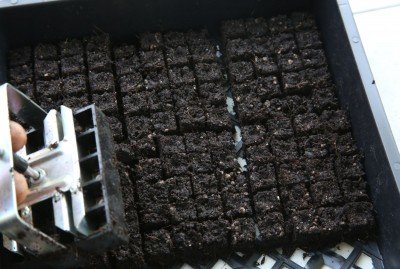
The blocks don’t always stay all the way together, but the plants are really easy to pot out, and the roots don’t ball up.
The alternative to soil blocks is of course regular old garden trays with small pots for your seedlings. If they have drainage garden trays are fine, but make sure that you don’t drown them. Seeds need air to sprout and grown just as much as water and sunlight. Don’t let them get too dry either, because once your seeds are wet and have started growing inside, drying them out completely will kill them, much like they would kill a plant.
Also popular in spring garden centers are the round compressed plugs that come in a netting material. To me they work just as good as soil blocks, and you don’t have to worry about them disintegrating on you like you do with blocks, but from a survival perspective they are completely useless. Single use, when it comes to survival gardening, just isn’t going to cut it. That is part of the problem with the plastic plant trays. If you pick up a plant disease, sterilizing the tray isn’t so easy. UV light does kill most bacteria, but I don’t know a successful gardener who would use a plastic tray that plants have died in. Soil blocks can actually be put right on the ground, or even better, on cement or brick. If you pick up a plant fungus, build a fire on that piece of ground, or the cement or brick, and you’ll be fine to try it again.
Finding a Good Reference
Gardening books seem to be like opinions. Everyone has one and everyone thinks everyone else’s stinks. I have owned dozens of gardening books, old and new, and the one I find most useful is called The New Seed Starters Handbook by Nancy Bubel. There are more encyclopedic books with taxonomy of hundreds of varieties of plants, and there are more “newbie” books, but I find that though it was last updated in 1988, this book covers just about everything you need to know in one small volume that will get you out and doing it right very quickly.
The internet can be both a great and a crappy source of local gardening information. If you search around, you may find that someone in your location has devoted a whole bunch of spare time and effort to create an authoritative reference of soil types and pests in your area. Most likely not though. What you will most likely find is that your state university has a wealth of information from the “extension service” that was entirely bought and paid for by the ag industry. They will happily test your soil for free usually, so that they can suggest the “products” that will make your soil just right. The problem is that in a survival situation, you will most likely have to make due without it, and in the meantime your soil has had all the good stuff killed off by the chemicals that your neighborhood extension agent has insisted that you must have.
Organic vs. Conventional vs… GMO?
So called “organic” farming is a legal term since the FDA took over the labeling in 2002 of organic foods. If you Google around about it, you will see that organic is fraught with inconsistencies and even outright fraud, and that the FDA has been complicit in the circus that has become “organic.” For your own garden, “organic” or not depends on what you personally want to do, because we are not talking about selling your produce here, which is the only time that the rules of organic apply. Do you want to make your own fertilizer from some kind of animal waste or compost? Do you want to buy regular old fertilizer? What about insect control? If you sprinkle some “Seven” around the corners of your garden there is no way you could ever be certified organic, but do you really feel that there will be adverse health effects from veggies planted in the general vicinity? I warn people that if you plan to “go organic,” you had better get some experience under your belt. Because one of the things you can store for survival is some regular old chemical fertilizer, and that stuff works. Remember that the original name of the Whole Foods chain (I used to shop there in Cambridge Mass.) was “Bread & Circus.” Look that term up for an interesting perspective of what they were really trying to accomplish.
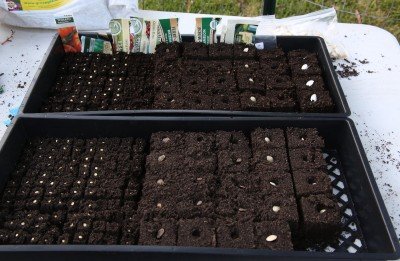
These are the soil blocks with seeds in them before covering with a little more soil. Most seeds are safe to sow at twice their thickness deep, but some seeds like light, heat, cold etc. Get the New Seed Starters Handbook as a reference.
GMO is a whole other story. Genetic modification of plants has been around for decades now, and the science on GMO was very rushed, and done by the companies who sell the stuff with no supervision. You may think that the FDA is a real watchdog government entitity, but they aren’t. FDA has had a revolving door of executives with Monsanto, Dupont and others in the global ag business, and at this point I wouldn’t trust them with a $20 bill to go get a pack of smokes and a rack of beer, let alone our food security. The good news is that there are very few actual plants that are affected by genetic modification. Corn and soybeans are the big ones, but canola and now sugar beets have now gone almost entirely GMO as well. Corn and beets are wind pollinated, so if you live in one of the regions where commercial crops are grown, be aware that after one season your corn or beets will also be GMO, and you will in violation of patents on those crops. Unfortunately there is little you can do to avoid that, other than move. Corn in the most remote regions of Mexico, where corn most likely originated, has been tested positive for GMO contamination. GMO is a mess.
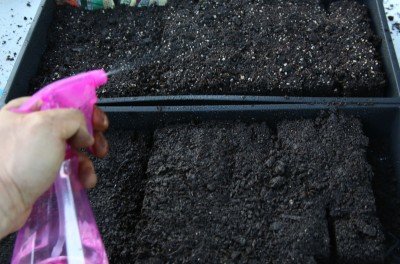
I use a spritzer with RO water to get my seeds going because the blocks fall apart easy unless you use a really heavy mix.
Garden veggies like tomato and watermelon haven’t been approved for GMO in the US thankfully, so regardless of whether you play $1.29 for a pack of seeds on Ebay or $3.49 for top of the line “organic” seeds in the special rack at your garden supply store, they won’t be GMO. You should however be aware of what are called F1 hybrids, which I covered in the first article. The consumer seed companies have been great about labeling F1s for several years now. If you don’t intend to save your seeds this year, by all means feel free to choose an F1, because they are often really great to eat, but if you intend to save the seeds, next year’s will mostly likely not be as good as this year’s.
Potting Up
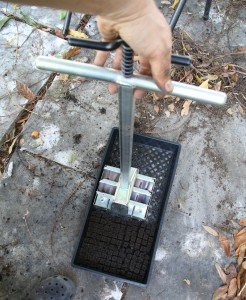
The six and 12 block sizes have a long handle, but there isn’t much advantage to the small scale gardener.
No this isn’t about growing weed in Colorado. Potting out is when you move your seedlings to either a larger pot or soil block, or you just move them outside to a garden. If you live in the northern climes and you have the room, I strongly suggest you build at least a small greenhouse. My article on water mentioned that I used to have a greenhouse in the hills of western Massachusetts and that even when the outside temp got down to below zero, the grass in my greenhouse was always green. Now that I’m in Florida I have experienced everbearing year round tomato plants, but I never thought to try that in my greenhouse back then. No matter what, if you have the room for one, a greenhouse will give you a jump on spring that most gardeners will only be able to envy. I used to start my seedlings in those 1/2″ blocks on a warming pad in my basement, then pot them up to the 2″ blocks in the greenhouse before putting them out after about May 15th.
Container gardening is not as far fetched as you might think. If you see things labelled “hydroponic,” it sure sounds natural, but it is really just growing plants on porous rocks using chemical fertilizers. You don’t need a lot of dirt or land to grown plants. You need nutrients and water, and sunlight. I have very little experience with it, so I am planning on potting these seedlings up to 5 gallon grow bags and set up a drip irrigation system. How complicated could it be?
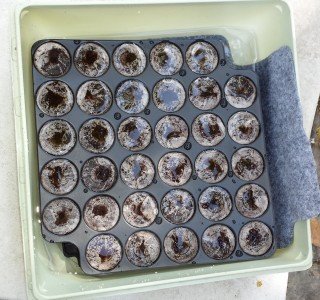
If you start with the round plugs, soak them first, and don’t use too much water once the seeds are in, or they will rot.
Canning for Survival and Sanity
Your first year of gardening will teach you a valuable lesson. It is pretty easy to grow more veggies than you could possibly eat yourself before they go bad. Summer squashes are the worst. They just keep coming. But have no fear, we are going to get to canning shortly. And if you are adventurous, don’t wait for me. Go buy a $69 Presto canner and follow the directions. It isn’t that hard, nor is it expensive. I plan to start my series on canning with regular glass Mason jars (available at Walmart as is the canner sometimes), but I’m going to use my rocket stove as the heat source.
I have always felt that you can never get anywhere unless you have a target to aim at. Like with shooting, rarely will you hit the center of the target even on your best day. But if you can come up with a steady rest and some good concentration, you have a good chance of at least getting close. And in the worst possible outcome, you still managed to get your shot into the general direction in which you were aiming. Survival is the same way. Ultimately it is not me who will adjudicate whether I survive what is inevitably a collapse at this point, but if I see in my minds eye how me and mine could potentially survive, maybe we’ll end up in that general direction at least. I also wish you well in this regard.


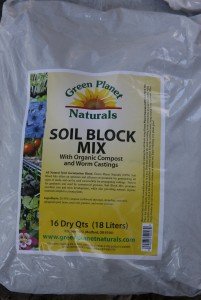
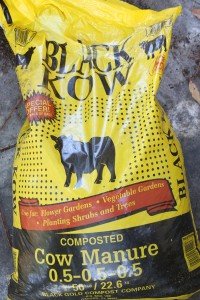
Hey Paul, I really enjoy reading your articles. I was just thinking of a topic that may be of interest to your readers. In my opinion one of the most important commodities in the event of a long term power failure is salt, and the knowledge to use it for food preservation. As you probably know, prior to the days of refrigeration it was vitally important for the preservation of meats and was so important during the Civil War that it was one of the most frequently imported products through the southern blockade. The great thing about salt is you can buy it fairly reasonably in bulk and store it in 5-gal buckets pretty much forever. Even if it gets a little damp it is still usable for preserving meat.
Anyway, I’ve been sort of researching the subject and thought it might be something your readers may want to think about.
NH
I am a farmer and rancher and spent a portion of my youth homesteading in Alaska. The article was a good one for encouraging folks to get started on independent food production. I was not intended as a thorough treatise on survival food production. Congratulations to Guns America for addressing this probable eventuality. When? No one knows. To what extent? No one knows. Why or How? No one knows. At the end of the day hard times will be what and when they are. If a person is serious about survival living then there will come a time when that person realizes they will be unprepared for any of the doomsday scenarios. The mentally and physically prepared will most likely “prosper”, others will “survive”, maybe not so well but survive never the less, and depending on the event some if not many will fail and not survive. My wife and I propered on our homestead in Alaska because we took nothing for granted, posessed the skills to build, plant and harvest, hunt and fish, gather and prepare. We both could use hand tools and were prepared to work hard every day. Inspite of this we had the luxury of a modern support society with everything from nails to steel tools, to books and seeds. Our ancestors survived and so can we but should that day ever arrive it will be hard, most modern first world people will be completely unprepared. The third world will survive as it always has. Folks, this is not rocket science. Drop the technology and get back to the basics. Learn basic skills, be mentally prepared, and be flexible because our modern world may be either severly compromised or no longer exist. Gardening is not a bad place to start no matter where you live.
We are well aquainted with the grow more than you can eat or even give away. One year had so many pole beans the whole neighborhood got tired of picking them. Will be looking forward to article on canning. My parents did it every year.
As a lifelong gardener, professional agronomist, and farmer I find this article to be full of good advice. Spot on about the F1 hybrids, commercial fertilizer, and organics. The place the author really falls down is GMO’s. They are the most researched, regulated, and safe foods in our food supply. Transgenic technology allow the insertion of a single gene of known function into the plant without all the negative genetics that come with conventional breeding techniques. Genetic modification is the safest practice for improving plant genetics, no ifs, ands, or buts about it. Shame on you for including completely baseless statements devoid of fact about GMO’s in an otherwise good article.
An interesting article on hobby gardening. I’m not actually sure why it is in a prepping post and under that category most of the info is utterly useless in almost all collapse scenarios. Especially during the first years thereafter where food will be a resource any and all survivors (without the necessary food stores = 99%) will be forced to obtain at any cost – including their or your life.
Unless your “gardening efforts” are in a walled and or totally isolated and or inaccessible/defendable compound of several acres in size – it is extremely improbably that you will harvest anything – no matter how good your “gardening” skills might be. Worrying about foraging animals in a country side of starving foraging and generally well armed humans – is absurd. All the foraging animal will be hunted and eaten in the first three months.
In reality few people will likely be in locations where “gardening” will provide any significant food source due the necessary land, competition with human foragers and other resources required – not to mention seeds, fertilizers, water (planned and acquired for in advance) and or and labor effective hand tools necessary manage 1/acre/family member. Not considered and dependent on location is the source of and labor/energy necessary to lift and move water for food production – which is significant at even 1 acre. Most of you will envision a sprinkler system or at least a garden hose from a spigot tap as the way you will water your “survival garden.” The average persons ignorance regarding the actual planning, labor, basic resources (seeds, fertilizer, pest control and water) and energy required to provide their current diets without any outside support resources – is astounding. A more realistic article on minimal food production realities and understand that the one acre per person refers to one acre in production year round – not likely with a foot of snow on the ground:
http://www.farmlandlp.com/2012/01/one-acre-feeds-a-person/
I love these self appointed experts who think they have any kind of handle on what could potentially happen to everyone. If you bothered to read the other articles in the series you would see that we really have been introducing topics all along. This article is by people who are selling farmland. We are selling nothing, and merely helping people understand simple skill building that may help down the road. You can only store so much food, and in a total collapse, having a couple years of basic resources is probably going to be a good idea. But at some point you have to make new food, and few people know how to do that these days. The human foragers will be dead in a matter of months, and then it will be the survivors, most likely working together to build a new local society.
So maybe put your bud light down for a minute, turn of your dvr episodes of american idol, and maybe thing of weaning yourself from the prozac. People can help themselves to survive, and nobody is guaranteed of anything. We don’t want to do nothing like the fools who think that it is all useless.
As someone who has worked successfully in both commercial and research food production technology development for over forty years, I’m not exactly a self-appointed expert, but a paid one. Since a large amount of that time was spent in over twenty developing countries, I understand a little more about subsistence food production with limited resources than most. I’m reasonably certain by your tone (Mr. Administrator) that you wouldn’t know what limited resource food production expertise looked like if you were floating in it. You have no clue of either the scales, or the resource requirements necessary to produce food for the avg. family in collapsed society where resources we currently take for granted – are no longer accessible and or existent. Or for that matter how much those resource requirements will vary with their actual location and climate. Consequently, you don’t see how absurdly shallow this article is within the context and venue it was written. The article here is run of the mill gardening tips for city dwellers under current resource circumstances, and that’s fine for teaching “gardening.” Representing the article as adequate for “prepping” for what might be needed after a societal collapse is simply laughable to anyone who has spent any time trying to reliably produce food with limited resources. I’m not just criticizing, I’m challenging you (GOA) to produce better articles with enough depth to actually be useful to your readers. Really – potting soil, bagged manure and seed blocks for survival farming resources?
Regarding the referenced site – there are dozens of other subsistence and survival farming sites trying to get a handle on what is needed to feed a family without a grid and or gov. services support – and yes almost all are selling some king of – survival supplies. Oh, but wait, that’s just like your organization (GOA) selling firearms and ammunition as survival tools into the “Prepper” market. Even so, if you read many of the subsistence farming treatises you will note a common theme in them is to maximize ideal conditions and minimize challenges when estimating the amount of land needed to support a family. Estimates range from 1 acre person to up to 20 acres per generic family, with a generic educational background, in a generic location. Clearly, few authors have hand tilled 20 acres or hand watered it, dealt with pests by hand instead of chemicals, or treated live stock diseases without a vet or antibiotics. Food production using only hand labor is a far bigger problem than it is represented to be by either media or the gov. If our system goes belly up, we’ll all get some first hand experience at subsistence – or less than subsistence food production.
Mason would you agree that gardening is a useless skill in any type of survival situation? Or would you say it is a useful skill in some types of survival situations?
My grandparents grew all of their food for four people in a garden about 50X100 as I remember it. The nearest store was 20 miles away and they didn’t own a car or truck. Have to disagree on the idea of 1 acre per person. Must be government figures.
Great article on how to start a garden.
But, once started, especially if you are out in the country side, one of the biggest threats is foraging wildlife.
Would love to see an article on strategies for keeping out deer (our main competitor) as well as opossum, racoons, skunks, field mice, and any number of avian foragers.
Setting aside human attempts to forage your garden – Fencing and netting alternatives and approaches will be key in trying to maintain a productive yield of a healthy garden.
Great job!
Keep the articles coming! Even if things don’t go bad, this information should be known by every self-sufficient human on this planet. We spend too much time handing off our requirements and needs to survive to others in exchange for fiat currency. The best way to send a message that we don’t need or want the current corruptions is to handle our care to ourselves. Vote with your feet and the sweat of your brow, folks. They can’t take that away from you.
Keep it up Mr. Helinski!
The article stated that canola oil is now mostly GMO when in fact it is entirely gmo. It was invented in Canada in the late 60’s or early 70’s.
nice article. I’ve been gardening and canning for many years, grew up on a farm where we had to garden to survive. Canning is easy and you can do more than vegetables. Such as beef, chicken or pork and it will last a long time in a sealed jar. I know some folks who can fish as well. Follow the directions and be careful as everything is boiling hot (jars, lids rings and the item you are canning). Watch the pressure cooker gauge like a hawk so it doesn’t build up too much pressure, just as bad as too little pressure. Now’s a good time to start, the sooner the better and soon you’ll wonder why you didn’t learn long ago. Good luck and have fun in your garden!
Hey thanks, I look forward to your articles every month. I have learned a lot.
Great article. Lots of good information for a complete novice like myself. Thanks